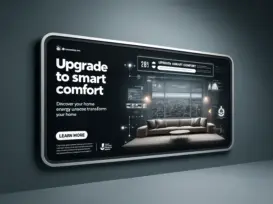Grus Home Energy - Thermostat
Understanding the Importance of a Thermostat in Regulating Home Temperature
Thermostats are a crucial component of any heating and cooling system in a home. They serve as the control center for maintaining a comfortable indoor temperature by regulating the operation of the heating, ventilation, and air conditioning (HVAC) system. Understanding how a thermostat works and the different types available can help homeowners make informed decisions about their home’s energy usage and comfort levels.
At its core, a thermostat is a device that senses the temperature of a room and signals the HVAC system to turn on or off to maintain a desired temperature setting. The most common type of thermostat is the programmable thermostat, which allows users to set specific temperature schedules for different times of the day or week. This feature helps homeowners save energy and money by adjusting the temperature when they are not at home or asleep.
There are also smart thermostats available on the market that can be controlled remotely via a smartphone or tablet. These devices offer additional features such as learning the household’s temperature preferences and adjusting settings accordingly, as well as providing energy usage reports to help homeowners optimize their heating and cooling systems.
When it comes to choosing a thermostat, homeowners have several options to consider. The most basic type is the manual thermostat, which requires users to adjust the temperature setting manually. While these thermostats are simple to use, they do not offer the energy-saving benefits of programmable or smart thermostats.
Programmable thermostats, as mentioned earlier, allow users to schedule temperature settings throughout the day. This feature can result in significant energy savings by reducing the workload on the HVAC system when the home is unoccupied or the occupants are asleep. Some programmable thermostats also offer features such as vacation mode, which allows users to set a temporary temperature setting while they are away from home.
Smart thermostats take programmable thermostats to the next level by offering additional features such as remote control and energy usage monitoring. These devices can also be integrated with other smart home devices, allowing users to create a more connected and efficient home environment. Some smart thermostats even have the capability to learn the household’s temperature preferences over time and adjust settings automatically.
In conclusion, a thermostat plays a vital role in regulating the temperature of a home and optimizing energy usage. By understanding the different types of thermostats available and their features, homeowners can make informed decisions about improving their home comfort and reducing energy costs. Whether choosing a basic manual thermostat, a programmable thermostat, or a smart thermostat, investing in a quality thermostat can lead to long-term savings and increased comfort in the home.
Blog, Energy & Electricity Basics , April 24, 2024 , Central Air Conditioning Thermostat, Electric Heating Thermostat, Fresh Air Thermostat, Heat Pump Thermostat, Home Thermostat, Smart Thermostats, Solar Water Heater Thermostat, Thermostat, Thermostat Type, Thermostats Types, Underfloor Heating Thermostat, Water Heater Thermostat
©2025 All Rights Reserved. Grus IoT Co.,Ltd.
